Doctor! Wasn’t that quite loud? Yes. No wonder you’ll definitely get your prefix “Dr” now or later. But how satisfied are you with your degree in the end? Where are you lagging? Is it that hard or are you not given the right guidance to make your career joyful and enjoyable while getting fruitful knowledge at the same time?
Discover simple ways to improve your clinical confidence every day, no matter where you are in your learning journey, whether you’re at the beginning or intermediate level.
The materials given below are purely for reference purposes only. In case of any copyright claims, do mail us at medxuryaid@gmail.com
STEP 1: STRONG FOUNDATION
Start upgrading right from your foundational subjects like Anatomy, Physiology, Genetics, Biochemistry, Immunology, Pathology, Microbiology and Pharmacology gives you a smooth flow while dealing with the cases during rotation. Sound knowledge in Physiology, Pathology and Pharmacology sharpens your therapeutic application. Though books cannot avail up-to-date trends all the time, some remain the gold standard in Medicine. Start working on foundations right away to get the essence of CLINICAL PHARMACY!
ANATOMY
- Principles of Anatomy and Physiology – Gerard J. Tortora
- Human Anatomy – B D Chaurasia
PHYSIOLOGY
- Textbook of Medical Physiology – John E. Hall & Michael E. Hall
- Netter’s Essential physiology
- Lippincott’s Illustrated Reviews – Physiology
MOLECULAR BIOLOGY AND GENETICS
- The Molecular Biology of the cell – Bruce Alberts, Alexander Johnson
- Principles of Genetics – D. Peter Snustad
IMMUNOLOGY
- Immunology (Multiple Books) – Abdul K. Abbas
- Immunology – David Male
- Janeway’s Immunology – Kenneth Murphy
- Kuby Immunology – Punt, Stranford
BIOCHEMISTRY
- Harper’s Illustrated Biochemistry
- Biochemistry – U. Satyanarayana
PHARMACEUTICS
- Remington’s The Science and Practice of Pharmacy
- Aulton’s Pharmaceutics – The science of dosage for design
- Ansel’s Pharmaceuticals of Dosage form and Drug Delivery system
- Pharmaceutics – I – R.M.Metha
PATHOLOGY
- Robbins Pathology Books – Kumar, Abbas & Aster
- Lange Pathophysiology of Disease – Gary D. Hammer
- Netter’s Illustrated Human Pathology
- Textbook of Pathology – Harsh Mohan
PHARMACOLOGY
- Goodman & Gilman Manual of Pharmacology and Therapeutics
- Netter’s Illustrated Pharmacology
- Lange Basic and Clinical Pharmacology
- Lippincott Illustrated Reviews Pharmacology – Karen Whalen
[/vc_column_text]
STEP 2: THEORETICAL APPLICATION
Yes! Now you will be perfectly ready to learn theoretical applications on patients. This part might be hard for all three. Earlier things you studied as an individual subject, now matter to integrate all together. This is the phase where you have to make your own system, ideas and strategies to compile all the foundational knowledge to start building your effective therapeutic base. This step involves updations in all foundational subjects as medicine is uncertain. You can stick to updated national and international guidelines, research studies, reviews and case books. Below listed are a few gold–standard books you can hold as the mainstay along with other online resources.
PHARMACOTHERAPEUTICS
- Pharmacotherapy : A Pathophysiologic Approach – Joseph T. Dipiro, Gary C. Yee et.al
- Standard Treatment Guidelines
- Pharmacotherapy Casebook : A Patient–focused Approach – Terry L. Schwinghammer
- Clinical Pharmacy and Therapeutics – Cate Whittlesea & Karenhodson
OTHER RESOURCES
- Current Medical Diagnosis and Treatment
- Lange: Case Books
- Oxford Case Histories
STEP 3 : PRACTICAL APPLICATION
One cannot study complete theory and later applies on real–world practice. Learning, Updating and Applying should occur parallel to delivering rational therapies. This step is real case-based learning. Start loving your PASSION : )
GOALS
Have clear Foundational concepts
Make your own clinically relevant high-yield materials
Work out cases and refer back to papers
Analyse thoroughly with standard regimens
Try making Pharmacist interventions and Calculations right from the second year
Give your own summary for actual treatment guidelines vs physician treatment to understand the treatment approaches and thereby identify errors, deviations and exceptional.
Make this a habit : )
Documentation of cases as SOAP Note is indispensable way to evaluate your skills. Make sure you engage yourself in all the aspects of clinical pharmacy given below.
OVERVIEW OF SOAP ANALYSIS
DEMOGRAPHICS
Personal Details – Name, Age, Gender, Height, Weight, BMI, Education, Occupation and Department
Chief Complaints – List in the order of Importance
History of Present Illness – OLDCARTS
History – Medical, Medication, Surgical, Family and Social Histories
Alternate Medicine
OTC Products
Allergies
SUBJECTIVE
Subjective exposes the subject’s personal view on his/her condition, complaints and clinically relevant information in a short paragraph.
OBJECTIVE
Physical Examination
Vitals
Signs (of present illness)
Investigations (Lab, imaging and others)
ASSESSMENT
Diagnosis
Differential Diagnosis
Confirmatory parameter
Prognosis
Etiology
PLAN
Goals of the therapy (Highlighting the goals attained)
Plan (Surgical Procedure / Medical Management / Medication Management)
Treatment Chart
Treatment Summary
Drug Interactions
ADR (Suspected and/or Patient- Specific)
Medication Error
Pharmacist Intervention
Patient Outcome
Patient Counselling (Drug, Disease and Diet)
